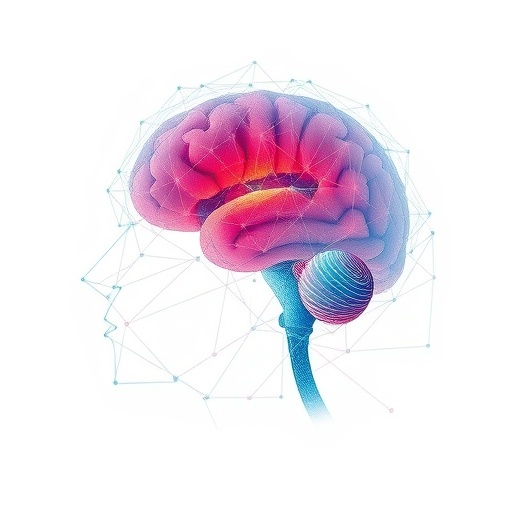In a groundbreaking study poised to reshape our understanding of tobacco use disorder (TUD) and its neural underpinnings, researchers have uncovered novel insights into how cigarette smoking alters brain connectivity at the hemispheric level. The investigation, published in BMC Psychiatry, specifically focused on the dynamic functional connectivity density (dFCD) within and between the left and right hemispheres of the male brain. This approach marks a significant departure from conventional whole-brain analyses, drilling down into inter- and intra-hemispheric patterns that illuminate the complex neural choreography affected by chronic smoking.
Traditionally, studies on brain connectivity in smokers examined static and global brain networks, often overlooking the asymmetrical and time-varying dynamics across hemispheres. This study employs resting-state functional magnetic resonance imaging (rs-fMRI) alongside a sliding window analytical technique to capture the temporal fluctuations of functional connectivity, which is a critical advancement in brain imaging. Dynamic functional connectivity density reflects how network connections evolve moment-to-moment, revealing a more nuanced landscape of brain function disrupted by tobacco dependence.
The research cohort consisted of 110 male participants, categorized into three groups: high dependence smokers, low dependence smokers, and non-smokers. Through this stratification, the study disentangles how varying degrees of nicotine dependence are associated with alterations in hemispheric communication. Distinctly, the study parsed functional connections into inter-hemispheric—connections spanning both brain hemispheres—and intra-hemispheric, those confined within a single hemisphere. This granular division allowed the researchers to map specific disruptions linked to tobacco use, unveiling patterns hitherto masked by global analyses.
One of the landmark findings reveals that all smokers, regardless of their dependence level, exhibited increased dFCD variability in the visual cortex across both hemispheres. This observation suggests that smoking may fundamentally influence the visual processing pathways or the stability of visual networks in the brain. The heightened variability indicates a potential instability in how visual information is integrated or processed dynamically in smokers, possibly implicating altered sensory perception or attentional mechanisms due to chronic nicotine exposure.
Crucially, when comparing high and low dependence smokers, the researchers identified distinct differences in connectivity dynamics localized to critical brain regions. High dependence smokers showed significantly elevated inter-hemispheric dFCD variability in the left insula. The insula, a key hub implicated in interoception, addiction, and craving, when exhibiting such increased variability, may reflect altered communication between hemispheres regarding the processing of bodily states and cravings, exacerbating addiction severity.
Conversely, intra-hemispheric dFCD variability was notably diminished in the right inferior frontal gyrus (IFG) and the right inferior parietal lobule (IPL) among high dependence smokers. Both regions are pivotal in executive function, impulse control, and attention regulation—faculties often impaired in addiction. Lower intra-hemispheric variability here suggests a reduction in the brain’s dynamic range for flexible cognitive control, potentially contributing to the compulsive smoking behavior observed in those with higher nicotine dependence.
Moreover, a significant correlation was established linking intra-hemispheric dFCD variability of the right IPL specifically to physical dependence, as opposed to psychosocial factors. This finding offers an intriguing biomarker potential, where neural dynamics in the right IPL may gauge the physiological grip of nicotine addiction independently of social or psychological influences. Such specificity enriches our understanding of the addiction’s biological substrate and could inform targeted therapeutic interventions.
The study’s emphasis on hemispheric specialization and differential functional connectivity provides compelling evidence that tobacco use disorder disrupts the balance and communication pathways between the brain’s hemispheres. Altered inter-hemispheric communication, especially involving regions like the insula, suggests that the bilateral integration of neural signals essential for maintaining addiction-related behaviors is compromised, revealing new frontiers for addiction neuroscience.
From a methodological standpoint, this research leverages the sliding window approach to extract temporal variability in connectivity strength, significantly enhancing the resolution with which brain dynamics are understood. Such dynamic analyses are crucial, as static connectivity snapshots fail to capture the fluidity of brain states that orchestrate complex behaviors like smoking. By dissecting temporal fluctuations, the researchers have identified biomarkers that not only reveal the impact of smoking but also potentially distinguish severity levels within addicted populations.
These insights resonate beyond the immediate scope of tobacco addiction and suggest broader applications for studying other substance use disorders and psychiatric conditions characterized by disrupted network dynamics. The differential patterns of inter- and intra-hemispheric connectivity could be instrumental in explaining behavioral heterogeneity and responsiveness to treatment across individuals.
By isolating specific brain networks such as the frontoparietal control network and insula at the hemispheric level, the work underscores the layered complexity of addiction neuropathology. It also opens avenues for novel interventions that might aim to restore normal connectivity patterns through neuromodulation or cognitive training targeted at these bilaterally interacting circuits.
In conclusion, this study from Zhang, Huang, Niu, and colleagues enriches the neurobiology of smoking by illuminating how dynamic, hemispherically distinct connectivity patterns are altered in TUD. Their findings advocate for a paradigm shift toward studying temporal brain dynamics and hemispheric specificity to unravel the intricacies of addiction. This nuanced understanding not only challenges previous notions of brain network dysfunction in smokers but also sets the stage for innovative diagnostic and therapeutic strategies that exploit the brain’s dynamic functional architecture.
As tobacco smoking remains a leading cause of preventable death worldwide, such neuroscientific breakthroughs hold the promise of informing public health strategies with greater precision. By leveraging neuroimaging markers of dependence severity and targeting the right hemisphere’s executive regions and insular connectivity, future interventions could better tailor treatments and improve outcomes. The dynamic interplay between hemispheres, revealed by this study, now emerges as a critical frontier in addiction neuroscience.
Subject of Research: Brain functional connectivity dynamics in tobacco use disorder.
Article Title: Altered inter-hemispheric and intra-hemispheric functional connectivity dynamics in male cigarette smokers.
Article References:
Zhang, M., Huang, H., Niu, X. et al. Altered inter-hemispheric and intra-hemispheric functional connectivity dynamics in male cigarette smokers. BMC Psychiatry 25, 758 (2025). https://doi.org/10.1186/s12888-025-07222-3
Image Credits: AI Generated




